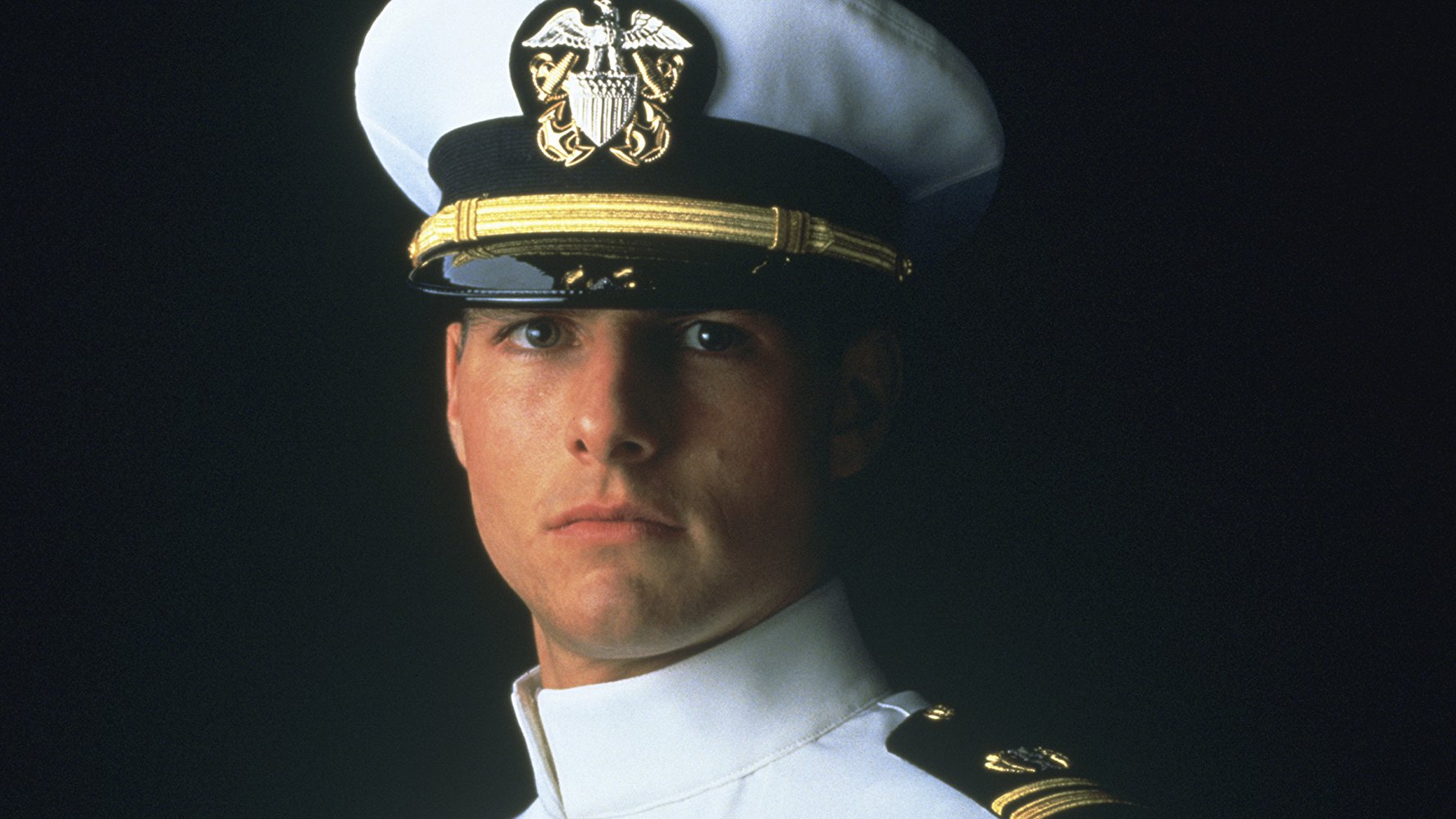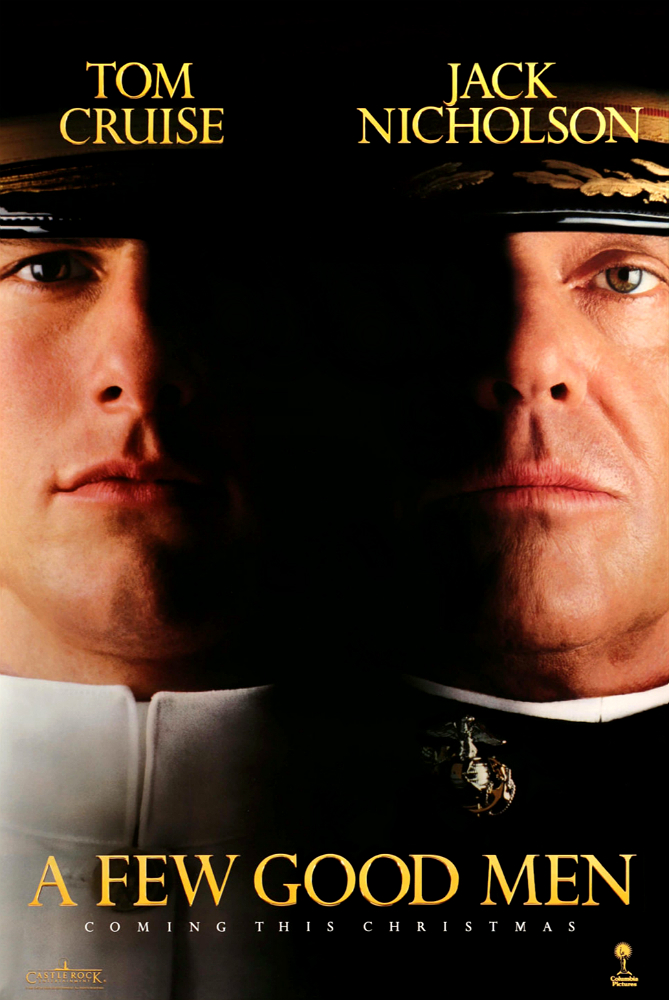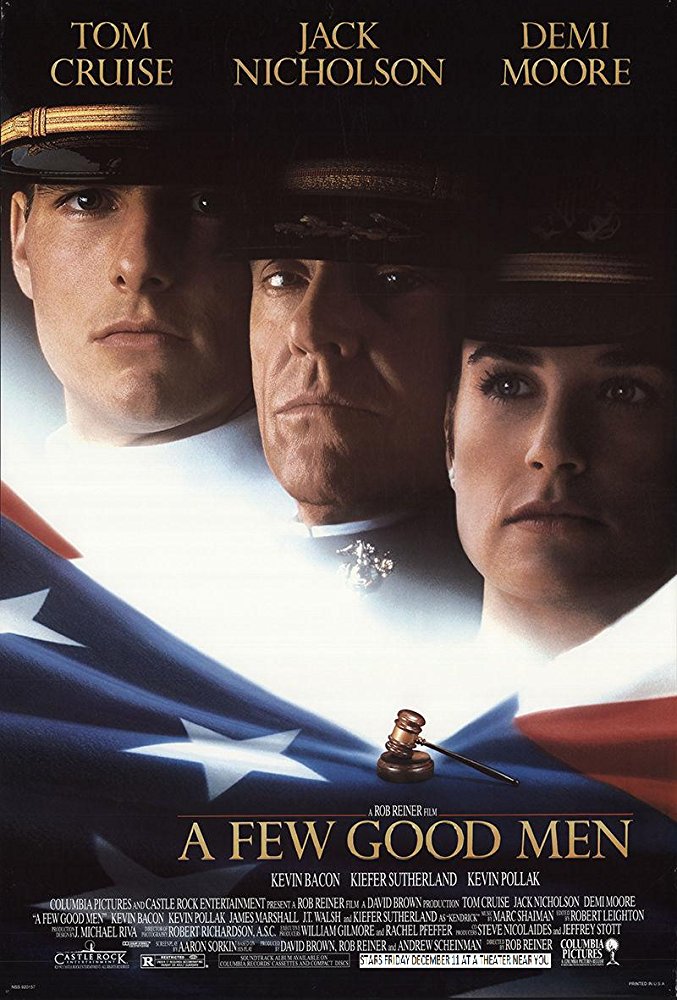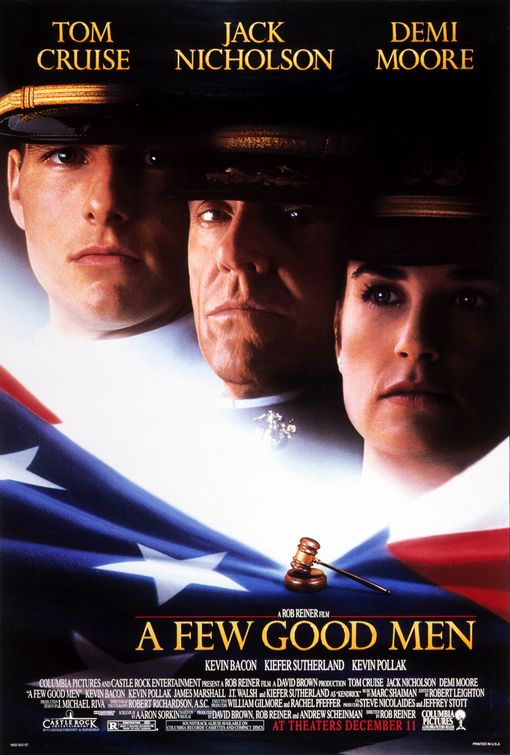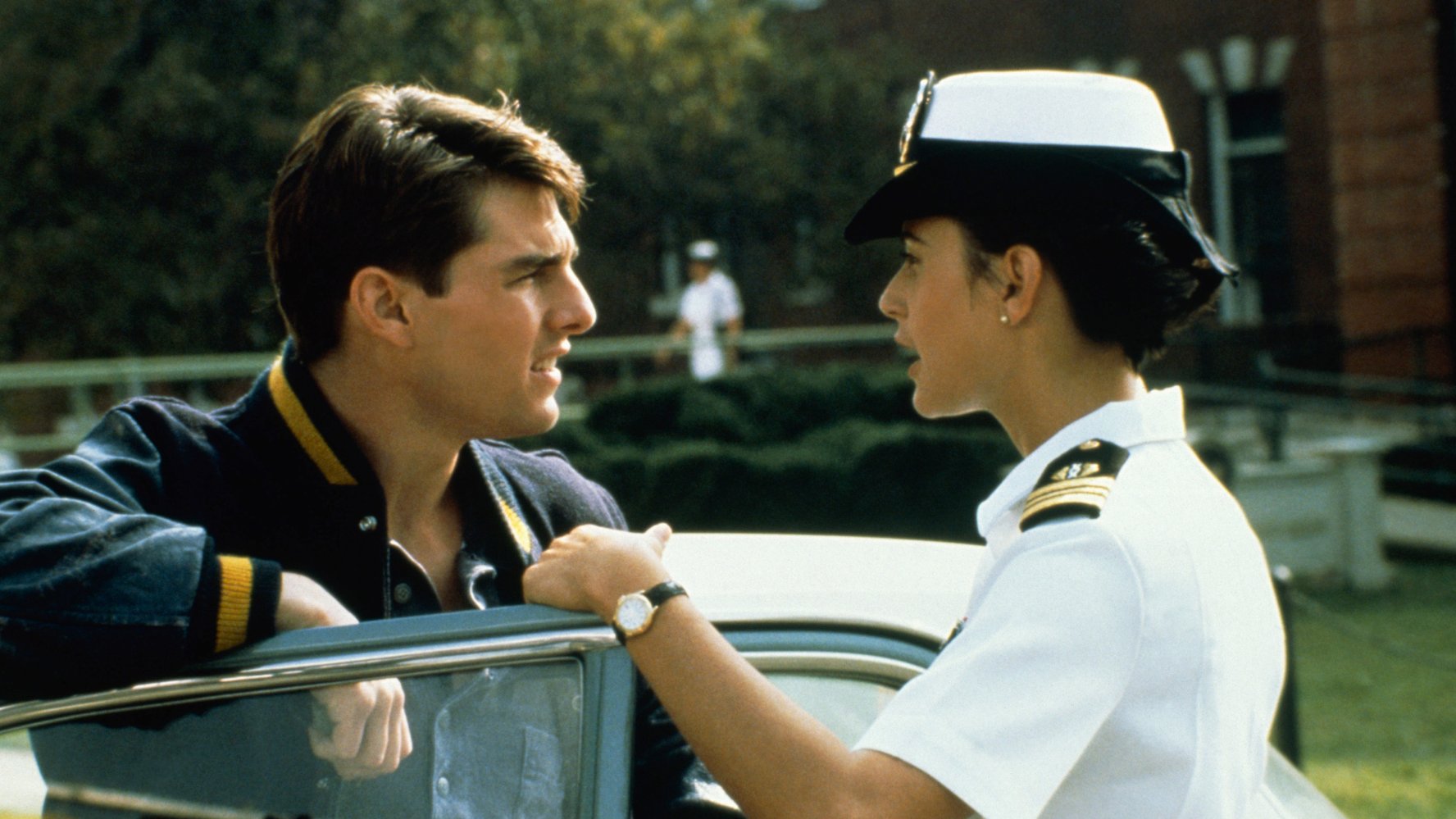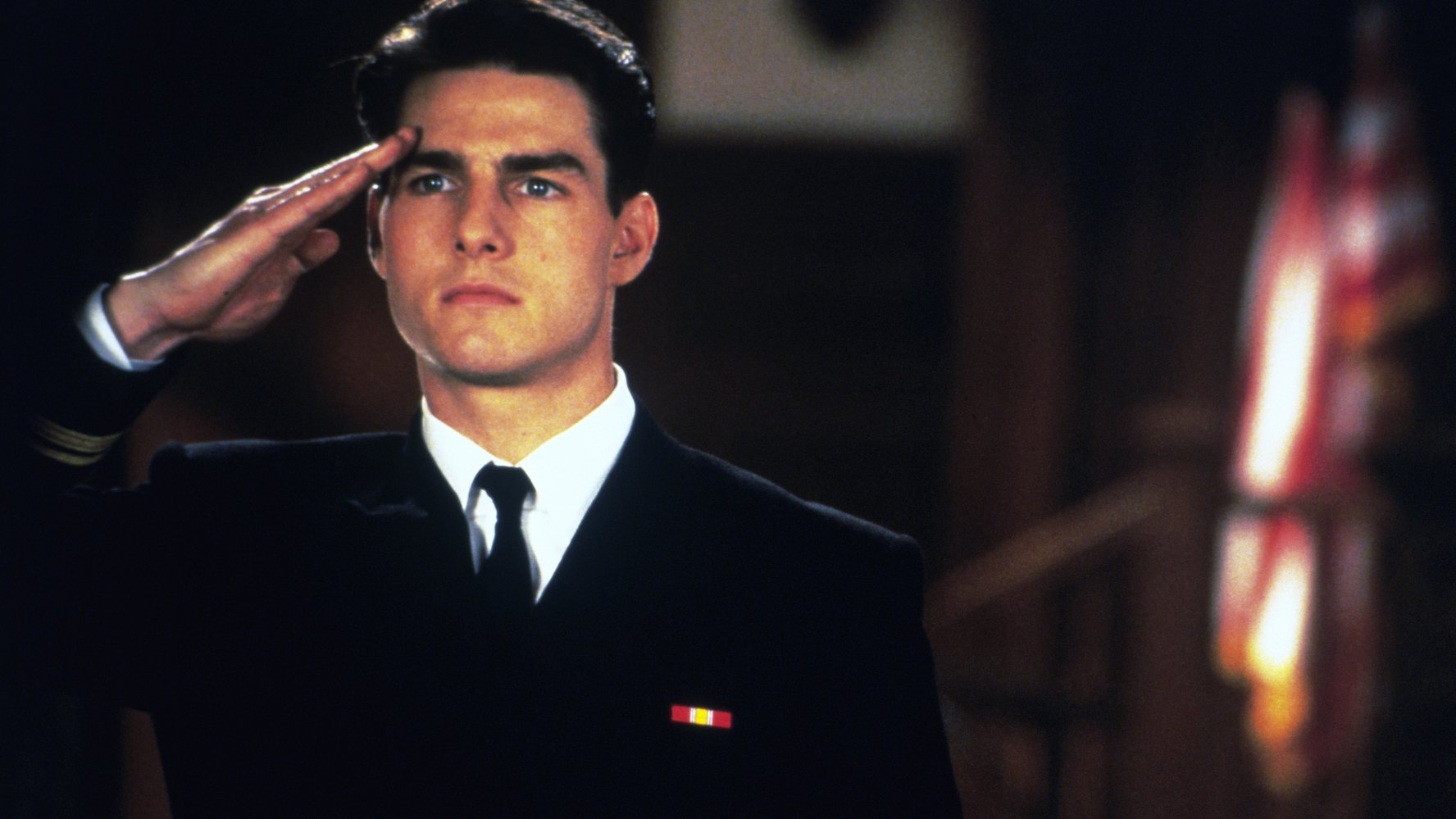LIEUTENANT (JUNIOR GRADE) DANIEL ALASTAIR KAFFEE USN (Tom Cruise), in A Few Good Men, was a Navy JAG (Judge Advocate General's Corps) officer, fresh out of Harvard Law School, with a scant nine months' experience, mostly plea-bargaining for various enlisted ratings accused of drug, alcohol, and other such offenses. Then one fine day the Division requested him to handle a murder case. It was one of the most sensational and embarrassing cases in the history of the Department of the Navy. And it turned Daniel Kaffee from a wheeler-dealer to a real lawyer. Contents [hideshow] 1. The Story 2. The Source 2.1. References: The StoryHe was born on 8 June 1964 at Boston Mercy Hospital, the only son of Lionel Kaffee, senior Navy JAG officer and later a civil-rights lawyer, and finally Attorney General of the United States. Sadly, the elder Kaffee did not live to see Daniel even enter law school, much less finish it--for he passed away in 1985.Young Kaffee graduated from Harvard Law School and joined the Navy--because he figured his father would want him to do that. For the first nine months, he laid low, handling the occasional minor offender. Typical was Signalman Second Class McDermont, facing charges of possession and being under the influence while on duty. Except the drug involved was oregano. In fact, Signalman 2/C McDermont had run afoul of the occasional anti-drug sting that NCIS' drug-enforcement arm occasionally ran. Lt. (jg) Kaffee got McDermont out of that scrap by threatening to bog down the prosecuting officer (Lt. (jg) David Spradling USN) with paperwork unless he agreed to charge the man with nothing more than a Class C misdemeanor and recommend sentence of fifteen days' restricted duty.In fact, in nine months of service he successfully plea-bargained no less than forty-four cases. This made him the most successful litigator in the Washington Navy Yard JAG Office. One more, he once quipped, and I win a new set of steak knives. His life changed when he reported to the JAG Office, and the OIC (Officer In Charge), Captain Whitaker, handed him the case of Lance Cpl. Harold Dawson USMC and Pfc. Louden Downey USMC, members of Second Platoon Bravo, Rifle Security Company Windward, Guantanamo Bay, Cuba. Charge: murder. Specification: in that, on Friday 6 September 1991, at approximately 2345 hours, Dawson and Downey entered the barracks room of Pfc. William T. Santiago USMC, seized him, bound him hand and foot, and gagged him, with the manifest intent to commit premeditated murder, the United States then being in a state of peace.The case was a departure from the usual routine from the beginning. Division insisted on the assignment of co-counsel, so the OIC assigned Lt. (jg) Samuel Weinberg USN to assist him. The OIC then ordered him to see one Lt-Cdr. JoAnne Galloway USN, Special Counsel for Internal Affairs. What jurisdiction she had, he could not fathom. Nor could he fathom what she expected him to do. Dawson and Downey had killed a man. If this case went to court, they wouldn't need a lawyer; they'd need a priest! But: a protracted investigation of the matter, and a public airing of fourteen letters Pfc. Santiago had written to everyone from CINCLANT (Commander In Chief, Atlantic) to his U.S. Senator and finally to NIS (Naval Investigative Service) (alleging an illegal fenceline shooting by Dawson), begging for a transfer, would prove an embarrassment to the Marine CO, Col. Nathan R. Jessup USMC, who was up for an appointment as Ops Director for the National Security Council. Kaffee was confident he could negotiate a sentence of twelve years for the two. But Lt-Cdr. Galloway wanted the case investigated further.When Dawson and Downey were moved to the Washington Navy Yard, Kaffee went about preparing for an upcoming softball game with the medical staff at Bethesda Naval Hospital. Galloway came to see him, and accuse him, frankly, of slacking. She insisted: Dawson and Downey never murdered anyone. He pointed out the cause of death was listed as pulmonary hemmorhage due to lactic acidosis, in turn due to internal poisoning with an unknown and untraceable agent introduce in the gagging rag. Galloway didn't buy it. She pointed out: at 0100 (actually, according to the record, 0037) Santiago was dead. At 0300 the doctor (Cdr. Stone) could not determine a cause of death with any certainty. Then at 0500 he certified death by internal poisoning. Oh, now I see what you're saying! he said derisively. It had to be Professor Plum in the library with the candlestick! In short, the implications of Galloway's read of the record blew right by him. Galloway threatened to go to his supervisor. Kaffee suggested she try to make her case to POTUS at the White House and reminded her that Division had requested him.And then she challenged him with the expression that would prove key to the case: Code Red. Kaffee and Weinberg went to see Dawson and Downey that afternoon. Kaffee asked Dawson what a Code Red was. A disciplinary engagement, Dawson called it. The story was simple: Dawson and Downey were in Santiago's room to give him a Code Red. For breaking the chain of command, to inform the NIS about a fenceline shooting, when he should have spoken to Dawson (as his squad leader), then his sergeant and section leader, then the platoon leader, and so on up the chain to Col. Jessup if he wanted to. Then and only then would have any business writing to the NIS.Kaffee left and returned to his office--where Captain Smilin' Jack Ross USMC, the prosecuting officer, started to negotiate. At first it was a rough go, as Kaffee expected. But when Kaffee uttered that phrase Code Red, Jack changed his tune. I'll give you the twelve years, he said. But before you go getting yourself into trouble at Gitmo, I think you should know: the platoon leader, Lt. Jonathan Kendrick USMC, held a meeting of the men, and specifically told them not to touch Santiago. The problem: even Lance Cpl. Dawson had not mentioned Kendrick's name. Kaffee didn't even know it. What was that all about?But Kaffee still thought nothing of it. Instead, when Cdr. Galloway came to apologize, and then reveal she had brought Pfc. Downey some comic books, he read the riot act to her for speaking to his client without his permission. (JAG officers often ignore rank when attorney-client privileges are on the line--or they do in this narrative.) She said she had authorization--from one Virginia Ginny Miller, Downey's aunt and next-of-kin! Finally she said, I'm going to Cuba with you tomorrow. And the hits just kept on coming.At Gitmo, a Cpl. Jeffrey Owen Barnes USMC escorted them to the Windward side--past the fenceline. He urged them to put on camo jackets over their white uniforms.Col. Nathan R. Jessup turned out to be a no-nonsense officer who exuded enough oil to run a Diesel engine. His XO, Lt. Col. Matthew Andrew Markinson USMC, struck Kaffee as a well-meaning but frankly weak man. Lt. Jonathan James Kendrick USMC was clearly a fanatic--even quoted the Bible to Kaffee and suggested Santiago died because he had no code, because he had no honor, and God was watching. What was this? Didn't Santiago die from an act of murder? Why should Kendrick say a thing like that? But that was lost on Kaffee then. So also was seeing Santiago's possessions hanging neatly in his closet, or folded neatly in his footlocker--all nice and shipshape, as Marines are taught to keep themselves at all times.At lunch that afternoon, Jessup revealed Santiago was due to be transferred off the base at 0600 Saturday 7 September 1991--on the first flight out. That surprised Kaffee, but again that was lost on him then. Galloway tried to cross-examine Jessup on Code Reds and whether they still went on at Gitmo, in direct violation of a CINCLANT directive sent to all COs, OICs and OTCs (Officers in Tactical Command, the Commodores who command task forces at sea) in the Atlantic Fleet Command. For answer, Jessup suggested to Kaffee that he, being associated with a sexually attractive woman who outranked him, was the luckiest man in the world on that account. Then he said, with the hint of a growl in his voice, I eat breakfast three hundred yards from four thousand Cubans who are trained to kill me. So don't think for one second you can come down here, flash a badge, and make me nervous. Kaffee felt an instinct. What would Jessup say if he asked for a copy of the order of transfer? There was one way to find out, and Kaffee took it. For answer, Jessup said, I want you, in your faggotty white uniform, and with your Harvard mouth, to extend me some f***ing courtesy! You have to ask me nicely! Wow. Kaffee made an effort to ask him nicely. Back at the Washington Navy Yard, Galloway came to see Kaffee in his off-the-Yard quarters, and stunned him with this news: Markinson had gone UA (Unauthorized Absence) shortly after they left Gitmo. Galloway was also assigned as Louden Downey's attorney, with authorization from Aunt Ginny. She then said, Lt. Kendrick ordered those two to do the Code Red. And you know it. Kaffee suggested they all challenge Dawson and Downey with that suggestion. To his complete surprise, they did so confirm. Kendrick had, of course, held a meeting with all the men in the platoon at 1600 hours. But then, at 1620, Kendrick had entered the barracks room of Dawson and Downey, and then and there given Dawson an order to give Santiago a Code Red.Kaffee and Galloway challenged Smilin' Jack with that order. For once, Smilin' Jack didn't smile. He then offered another plea deal: knock the charge down to involuntary manslaughter, that carried a two-year penalty. In fact the two would be home in six months with time off for good behavior. Galloway was inclined to reject the deal and go to trial. Kaffee wasn't. But Dawson vituperatively refused to dishonor myself, my unit, or the Corps, so that I can go home! In six! Months! Sir! Kaffee was furious. He wanted to beg off from defending the case. Weinberg reminded him all he need do was wait for the judge to ask him to enter a plea, then request different counsel be assigned. Galloway said, Be sure and ask him nicely. She hammered Kaffee. I want you to let them be judged! she said. I want you to make an argument! When Weinberg said such arguments hadn't worked for Lt. William Calley USA at My Lai, or for the Nazi defendants at the War Crimes Trial, Kaffee rebuked Weinberg: That's not the same as two teen-aged Marines executing a routine order they never imagined would bring harm! Don't look now, said Galloway, but you're making an argument. Kaffee still insisted on begging off the case. He felt that way when he went to his favorite bar and heard two lawyers talking about making their opponents go blind on paperwork because old men misread insurance statutes.But when he walked into the courtroom, and faced Col. Julius Randolph USMC, the judge of the case, everything changed for him. In that august room, he realized he couldn't back away from this. It would be the final shame to his pride. So when Col. Randolph asked him to enter a plea, he said, Yes. Not guilty. Randolph scheduled trial three weeks from that day, on Thursday 3 October 1991.Before a shocked Galloway could ask him what changed his mind, he asked, Why does a lieutenant (junior grade) with nine months' experience and a track record for plea-bargaining get assigned a murder case? Could it be so it would never see the inside of a courtroom? Then he issued rapid-fire orders to Galloway and Weinberg to acquire office supplies, medical reports, and P & C reports on Dawson, Downey and Santiago. So this is what a courtroom looks like! he finished before a smiling Galloway and a dubious Weinberg.Over the next three weeks, the three prepared a defense, and Dawson and Downey as witnesses. The defense centered on intent (the government still could not prove poisoning to a moral certainty), Code Red (a common practice at Gitmo), and the order ((A) Kendrick gave it, and (B) Dawson and Downey had no choice but to obey it). But before the trial began, Kaffee was still convinced they would lose.Still he plowed on. When the NIS investigator testified, he drew out an admission that the NIS had no evidence to charge Dawson with firing at the enemy without cause. When a corporal testified to Lt. Kendrick's order not to touch Santiago, Kaffee made him admit he wasn't in Dawson and Downey's barracks room later that day. And he stopped Smilin' Jack from calling 22 other witnesses by forcing him to concede: they weren't in that barracks room, either.The doctor's testimony, which the doctor gave the next day (Friday 4 October), presented the first problem. Kaffee tried to exclude, then to cast doubt on, Dr. Stone's testimony. The witness is an internist, not a criminologist. The medical evidence is doubtful. Still the court overruled his objection. Kaffee still got in a suggestion that Santiago had an unsuspected heart condition that had caused the lactic acidosis--though the doctor tried to deny that. Galloway nearly ruined everything by renewing the defense objection, to the point that the judge said, The witness is an expert, and the court will hear his opinion! This caused Galloway and Weinberg to quarrel over their opinions of the defendants. Kaffee, seeing this, ordered everyone to take the night off.That night, Galloway came to ask Kaffee out on a date. There she told him how much she admired him as a lawyer. She was confident of victory. He was not.The trial did not reconvene until Monday 21 October. Kaffee first called Cpl. Barnes. From him Kaffee drew a description of Code Red, and an example from his own experience--on the receiving end. Smilin' Jack drew out the fact that no book mentioned Code Reds. On redirect, Kaffee drew out that the mess hall wasn't in the book, either, but everyone still knew where it was.That night, Kaffee went out to buy a newspaper. When he got back into his car he realized he had an unscheduled and uninvited passenger! And who should it be but Markinson! Who told him the transfer order was phony. Not only that, but Santiago could have flown out at 2300 hours 6 September, on a flight that landed at Andrews AFB (as it was then known; it is now known as Joint Base Andrews) at about 0205Q 7 September. (Time zone Q for Quebec means four hours behind Coordinated Universal or Zulu Time; this corresponds to Eastern Daylight Saving Time in civilian notation.) Kaffee checked Markinson into a cheap hotel and immediately summoned his associates. Galloway used her special clearance code to arrange for U.S. Marshals to guard Markinson. Sam Weinberg went out to requisition the tower chief's log from Gitmo.Kaffee then saw Smilin' Jack at a bar. And Smilin' Jack told him--officially--that if he, Kaffee, accused Kendrick or Jessup of any criminal act without sufficient evidence, he, Kaffee, would face court-martial for unprofessional conduct and a Bad Conduct Discharge from the Navy.The next day, Kaffee hammered Kendrick as hard as he could. But he could never get Kendrick to admit he had ordered Dawson and Downey to give Santiago a Code Red.That night, Weinberg presented the tower chief's log from Gitmo. No flight at 2300. Kaffee confronted Markinson, who in a worried tone blamed Jessup for erasing the log entry, and also doctoring the tower chief's log at Andrews.Kaffee still told Markinson to expect to testify. In court he examined Pfc. Downey to get him to testify to getting the Code Red order. But then Smilin' Jack drew out a devastating disproof: Downey wasn't even in the barracks room! He had acted under the direct orders, not of Kendrick, but of Dawson.Another piece of frightful news followed this one: Markinson had committed suicide. Despite federal marshals guarding his door, he had put on his full-dress uniform, stood in the middle of his hotel room, drawn a nickel-plated automatic from its holster, and fired a bullet into his mouth.Kaffee got drunk on the strength of it, somehow managed to drive back to his apartment without crashing or getting stopped by a cop, and told Galloway and Weinberg what he had heard. Galloway then proposed asking for a continuance--to subpoena Col. Jessup. Kaffee thought that was six kinds of foolish. Galloway insisted Kaffee could get from Jessup that he, Jessup, had ordered Kendrick to order Dawson to give Santiago a Code Red. Kaffee became terrifically angry and threw all the papers from their work table in response, calling Galloway galactically! STUPID! Galloway left--walking back home in a driving rain.Back at Kaffee's apartment, Weinberg quietly told Kaffee he, Weinberg, found Kaffee a better lawyer than his father had been. And he said, I wouldn't put Jessup on the stand. Your father wouldn't. But neither Sam Weinberg nor Lionel Kaffee is lead counsel in the case of United States Government v. Dawson and Downey. So: what are you going to do? Kaffee and Weinberg then drove along the street, found Galloway trudging in the rain without good rain cover, urged her to get into the car, and assured her they would indeed subpoena Jessup.Next morning, Kaffee excitedly told them what he was thinking: Jessup wanted to say he gave that order. The clue: how Jessup had behaved toward Galloway and Kaffee at Gitmo. Shake him, put him on the defensive, and lead him right where he was dying to go. That was the plan.And Kaffee figured out how to do it--when, as he was retrieving his baseball bat, he saw his own uniforms hanging in his closet--shipshape. Like Santiago's room. That led him to a series of thoughts about how to challenge Jessup on inconsistencies between his avowed intentions, and the facts.On the last day of the trial, Kaffee was ready--as soon as Weinberg came in with two airmen from Andrews who--or so it would appear--could testify to receiving a plane from Gitmo at 0205Q on 7 September. Kaffee challenged Jessup, first with Santiago not having packed for any trip, and second, Santiago having made no phone calls at all on the day of his supposed intended transfer. He introduced the doctored tower chief's logs from Gitmo and Andrews and announced he would call the two airmen from Andrews.Then he got to the meat of his argument: if Lt. Kendrick (at Jessup's order) had given an order that Santiago wasn't to be touched, and the orders of Jessup and Kendrick and all officers at Gitmo were obeyed without question, why did Santiago need a transfer?And so Kaffee made his suggestion: Lt. Kendrick ordered Dawson to give Santiago a Code Red, because that's what Jessup had told Kendrick to do. And when it went fatally wrong, Jessup cut Dawson and Downey loose: by ordering Markinson to sign a phony transfer order five days after the fact, by doctoring two tower chief's logs to remove all record of a flight from Gitmo to Andrews, and by coercing the base hospital medical director to infer poisoning where none had even been attempted. Then, shouting to make his voice carry over the outraged voices of Smilin' Jack and the judge, he asked, COLONEL JESSUP! DID YOU ORDER THE CODE RED?!? And Colonel Jessup, for about a minute, poured out an angry and contemptuous self-justification. And ended by answering Kaffee's repeated question, YOU'RE G_D-D____D RIGHT I DID! The court removed its members, and held an Article 39A session to Mirandize Jessup and place him under arrest. Jessup, of course, was beside himself with rage. He lunged at Kaffee--so a squad of Marine MPs had to restrain him--and screamed out a clearly NSFW threat against him. (Not safe for civilian work, anyway.) Then he said, All you did today was weaken a nation. Sweet dreams, son. And Kaffee stared him straight in the eye and said, Don't call me 'son.' I am a lawyer, and an officer in the United States Navy. Only later would he think about what that statement meant, and how it showed how much he had changed.The next day, the verdict came in for Dawson and Downey:On the murder charge: not guilty.On the conspiracy-to-murder charge: not guilty.But on a charge of conduct-unbecoming: guilty as charged.Sentence: time already served, and dishonorable discharge from the Marine Corps for both men.Downey, upset, insisted, WE DID NOTHING WRONG! Dawson, however, recognized they ought to have fought for Santiago. Kaffee assured Dawson he did not need shoulder chevrons to have honor. For answer, Dawson called out, 'Ten-HUT! There's an officer on deck, and gave him a heartfelt salute. The two had never even liked each other before then.Smilin' Jack looked on Kaffee with newfound respect. If anything, their friendship would go even deeper. The Unwritten Universal Attorney-to-attorney Respect Law would so mandate.Lieutenant Junior Grade Kaffee walked out of that courtroom a changed man, and a changed officer. What he did with his Navy career, the narrative does not make clear. We can probably infer that he stayed in the Navy longer than his originally planned three years. Because now the Navy was no longer a mere stepping stone, but an institution to which he was proud to belong.The SourceIn July of 1986, a Marine (rank unspecified) named David Cox, member of the real Rifle Security Company Windward, Second Platoon Bravo, along with nine other Marines, entered the barracks room of a Pfc. William Alvarado, and gave him the Code Red treatment. Pfc. Alvarado, like Santiago (see above), was a screw-up and a malingerer. And again lilke Santiago, he had ratted on a member of his unit over an illegal fenceline shooting. So the group seized him, gagged him with an over-the-mouth stuffing gag, bound him hand and foot, pummeled him, and shaved his head. Alvarado's lungs filled with fluid, and he coughed up blood and passed out. But unlike Santiago, he lived.Most of the Marines copped pleas and received less-than-honorable discharges. Marine Cox and two other Marines refused the plea bargain and insisted on trial by court-martial.Lieutenant (jg) Donald W. Marcari USN was lead counsel for the defense in that case. The trial took place at Gitmo and not at the Washington Navy Yard. As a key part of the defense, Lt. Marcari asserted at trial that Cox and the others acted on the implied orders of their superior officers. (No record exists suggesting that the platoon leader or the ground force commander gave the sort of explicit orders that 1st Lt. Kendrick and Col. Jessup issue in this film. Nor does any reference material suggest the involvement of the Internal Affairs division of the Navy JAG Corps or of any Special Counsel for Internal Affairs taking any part in the investigation of the attack on Alvarado or the defense of Cox and his two fellow Marines.)The court found Cox guilty of simple assault, a misdemeanor. The court sentenced him to time already served and returned him to duty. He would win an honorable discharge from the Marine Corps three years later, with the rank of full corporal.When the movie came out, Cox resented to his dying day the changes Aaron Sorkin and the other scriptwriters made to the story, particularly the death of Santiago and the dishonorable discharges of L. Cpl. Dawson and Pfc. Downey.Tragically, Cox disappeared in 1994. Things at least one witness related to the media suggest some person or persons unknown entered Cox' home, abducted him, and also hijacked his truck. Authorities found his bullet-riddled body near a riverbank. They have not to date been able to solve the murder of David Cox. Before he disappeared, Cox planned to:1. Sue Castle Rock Entertainment for invasion of privacy, civil conspiracy, intentional infliction of emotional distress, and other torts. (Five members of the Code Red squad did so sue. Cox was preparing to join the case as a co-plaintiff when he vanished.)2. Co-author, with the former Lt. Marcari, a book about the case to set the record straight.The Marine Corps relieved Col. Sam Adams USMC, the commanding officer of the Marine ground force at Gitmo, of his command.Lt. Marcari eventually left the Navy to pursue a civilian law practice. He now is the senior partner in a law firm handling personal injury cases. Another member of his team did become a United States Attorney.References:David Cox, ex-Marine who felt A Few Good Men unfairly maligned him, found mysteriously murdered. The Baltimore Sun, 10 April 1994. http://articles.baltimoresun.com/1994-04-10/news/1994100064_1_marine-corps-david-cox-gung-ho-marineLaw Firm of Marcari, Russotto, Spencer and Balaban. http://www.donmarcari.com/
Show less «

